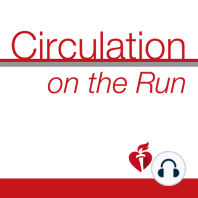23 min listen
Circulation March 03, 2020 Issue
ratings:
Length:
24 minutes
Released:
Mar 2, 2020
Format:
Podcast episode
Description
Dr Carolyn Lam: Welcome to Circulation on the Run, your weekly podcast summary and backstage pass to the journal and its editors. I'm Dr Carolyn Lam, associate editor from the National Heart Center and Duke National University of Singapore. Dr Greg Hundley: And I'm Dr Greg Hundley, director of the Pauley Heart Center at VCU Health in Richmond, Virginia. You know that problem we have with the development of calcification of the aortic valve, the aorta, etcetera with hemodialysis? Well, our feature is going to talk about the results of a randomized phase 2B study to address this. But first, how about if you get us started with a couple of your papers? Dr Carolyn Lam: In fact, it is a couple of papers and they're both related to hypertension. So in the first one, we know that exercise is associated with a lower incidence of hypertension, but what's the association of excessive levels of exercise in the incidence of hypertension? This question was examined by Dr Andersen from Uppsala University Hospital and colleagues, who compared the incidence of hypertension among almost 207,000 participants in a long-distance cross-country skiing event and more than 505,500 persons randomly sampled from the general population who are matched to the skiers on age, sex, and place of residence. Dr Greg Hundley: I love skiing! I want to be in the match group. Tell me, now, how long was this distance that they had to cover? Dr Carolyn Lam: Ah ha. Now the long distance event was really long. It was the Vasaloppet. I hope I pronounced that right, but it's a 45 to 90 kilometer skiing race. So participation, I'm sure you want to hear this, participation was associated with a 41% lower incidence of hypertension over the next eight years, compared to non-participation. And the better the performance in terms of percent of winning time, the lower the incidence of hypertension. If the observed associations are causal, it really adds to the list of beneficial effects of high, or even very high physical fitness. I can see you smiling, Greg. Dr Greg Hundley: This is your confirmation that the AHA wants to send us to Norway to do one of these recordings. Dr Carolyn Lam: Well, this next paper asked the question, what is the association of cumulated blood pressure exposure from young adulthood to midlife with gait and cognitive function in midlife. This is from Dr Mahinrad from Northwestern University Feinberg School of Medicine and colleagues who included 191 participants from the coronary artery risk development in young adults’ study, which is a community-based cohort of young individuals followed over 30 years. Cumulated blood pressure was calculated as the area under the curve for baseline up to year 30 exam and gait and cognition were assessed at the year 30 exam. Cerebral white matter hyperintensity was available at year 30 in a subset of participants who underwent MRI. Dr Greg Hundley: I heard that MRI word. So what did they find Carolyn? Dr Carolyn Lam: They found cumulative exposure to higher blood pressures from young adulthood to midlife, even at levels below the clinical definition of hypertension, was associated with worse gait and worse cognitive function in midlife. The impact of cumulative levels of blood pressure exposure was independent of other vascular risk factors during a follow-up period of over 30 years, and the higher burden of midlife cerebral white matter hyperintensity on MRI, Greg, moderated the association of cumulated blood pressure exposure with gait but not with cognitive function. Dr Greg Hundley: You've got me convinced we now have to go to Norway. But what did the authors think were the clinical implications of their study? Dr Carolyn Lam: Well, here it is. The deleterious effect of elevated blood pressure on brain structure and function may begin during early adulthood and this really emphasizes the need for all primordial, if you may, prevention of high blood pressure. But also reconsidering individual levels of blood press
Released:
Mar 2, 2020
Format:
Podcast episode
Titles in the series (100)
Circulation September 19, 2017 Issue: Circulation Weekly: Your Weekly Summary & Backstage Pass To The Journal by Circulation on the Run
